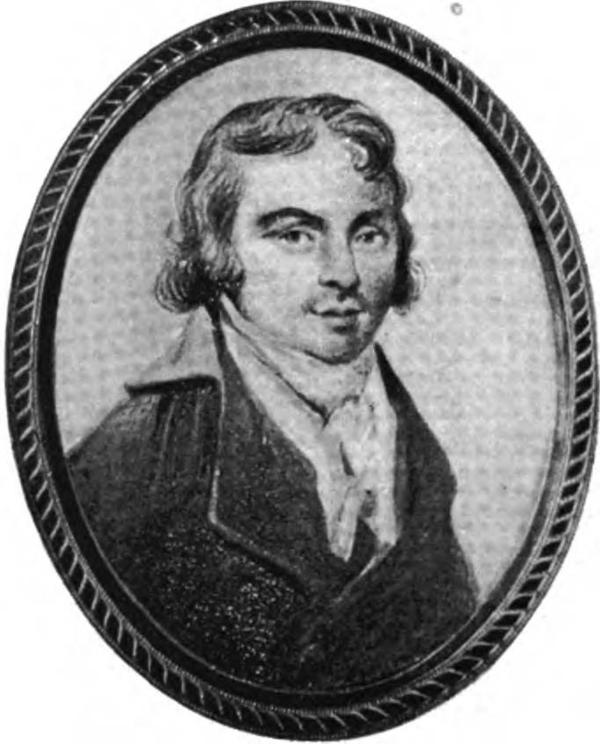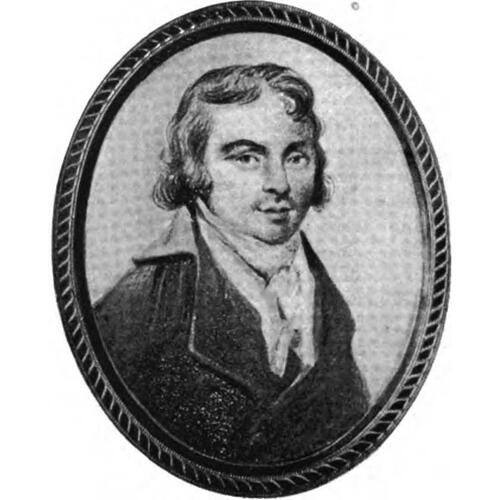As part of the funding agreement between the Dictionary of Canadian Biography and the Canadian Museum of History, we invite readers to take part in a short survey.

Source: Courtesy of Wikimedia Commons
HASWELL, ROBERT, fur trader; b. 24 Nov. 1768, probably in Hull, Mass.; m. 10 Oct. 1801 Mary Cordis in Reading, Mass., and they had two daughters; d. 1801 at sea.
The eldest son of William Haswell, a lieutenant in the Royal Navy, Robert Haswell had had experience at sea before joining the Columbia Rediviva as third mate at Boston on 30 Sept. 1787. This ship, commanded by John Kendrick*, and the sloop Lady Washington, under Robert Gray, had been fitted out by Joseph Barrell and five business associates to participate in the fur trade on the northwest coast. The log kept by Haswell during the voyage is extremely valuable, since it is the only surviving contemporary account of Boston’s pioneering adventure in the sea otter trade.
In the course of the voyage southwards through the Atlantic, Haswell rose to the position of second officer. At the Falkland Islands, after a dispute with Kendrick, he was transferred to the Lady Washington as second officer, a position he still held when the expedition reached Nootka Sound (B.C.) in September 1788. The following spring, while the Columbia remained at anchor in the sound, the sloop sailed along the coast seeking out Indians to trade with. On this trip Haswell met the Indian leaders Callicum and Muquinna* and gained a sufficiently intimate knowledge of the Nootkas to compile a vocabulary of their language. In July Kendrick sent the Columbia, with Gray in command and Haswell resuming his position as second officer, back to Boston via the Sandwich (Hawaiian) Islands and Canton (People’s Republic of China). She arrived at her home port in August 1790, having circumnavigated the globe.
Just six weeks later Haswell sailed in her again for the northwest coast, this time as Gray’s first officer. The ship reached Clayoquot Sound (B.C.) on 5 June 1791 and traded on the coast for the summer season, Gray following the owners’ instructions to avoid Nootka Sound, which was held by a Spanish garrison under Francisco de Eliza* y Reventa and Pedro de Alberni. The expedition wintered at Adventure Cove (Lemmens Inlet, Meares Island), where the 45-ton sloop Adventure was constructed. In March 1792 Haswell was placed in command of this tiny vessel, which proved to be “a very good seaboat,” and in April he sailed in search of trade to the Queen Charlotte Islands and the adjacent coast. On 17 June he made contact with Gray, who was sailing north after having discovered the Columbia River, and the next day, in Nasparti Inlet (B.C.), he delivered to the Columbia the sea otter skins and other pelts he had acquired. Shortly afterwards the Columbia struck a rock, and Gray was forced to call upon the Spaniards in Nootka Sound for assistance. The Americans established friendly relations with the men they had hitherto avoided, and on 28 September they sold the Adventure to the new Spanish commandant, Juan Francisco de la Bodega* y Quadra, for 75 prime sea otter skins. Haswell returned to the Columbia as first mate and sailed in her for Boston, arriving there by way of China late in July 1793.
In the next five years Haswell made two voyages to the East Indies. On 4 March 1799 he entered the United States Navy as a lieutenant, and he remained in the service until April 1801. During this time he served in the Boston, gaining a share of the prize money when she captured the French corvette Berceau. On 5 April Haswell, aged 32 and now residing with his family in Charlestown (Boston), left Massachusetts for the last time in command of the trading vessel Louisa. His proposed itinerary was familiar: around Cape Horn to the northwest coast, to China, and back to Boston; but the ship was lost at sea before reaching her initial destination.
Haswell’s success in his career indicates that he was a trusted officer and a competent trader, although John Box Hoskins, supercargo on the Columbia’s second voyage to the northwest coast, was ambivalent in his assessment. Hoskins admitted in his journal, “it is to him we are indebted for what knowledge we have yet attained” of the coastline. Nevertheless he wrote to Barrell, “Mr. Haswell . . . has said to his officers, that he would make 10,000 Dollars, he would then go to England that the Owners might go to hell and his wages and per Centage with them.” In his writing Haswell often underlined his own independence and good judgement, sometimes at the expense of his superiors; but he appears to have been an intelligent leader and a good navigator.
Robert Haswell’s “A voyage round the world onboard the ship Columbia-Rediviva and sloop Washington,” [1787–89], and “A voyage on discoveries in the ship Columbia Rediviva,” [1791–93], are at the Mass. Hist. Soc. The first of these logs, including the Nootka vocabulary he compiled, was published in Voyages of the “Columbia” to the northwest coast, 1787–1790 and 1790–1793, ed. F. W. Howay ([Boston], 1941; repr. Amsterdam and New York, [1969]), pp.3–107, and a portion of the second at pp.293–359. F. W. Howay, “Some notes on Robert Haswell,” Mass. Hist. Soc., Proc. (Boston), 65 (1932–36): 592–600.
Cite This Article
Barry M. Gough, “HASWELL, ROBERT,” in Dictionary of Canadian Biography, vol. 5, University of Toronto/Université Laval, 2003–, accessed April 1, 2025, https://www.biographi.ca/en/bio/haswell_robert_5E.html.
The citation above shows the format for footnotes and endnotes according to the Chicago manual of style (16th edition). Information to be used in other citation formats:
| Permalink: | https://www.biographi.ca/en/bio/haswell_robert_5E.html |
| Author of Article: | Barry M. Gough |
| Title of Article: | HASWELL, ROBERT |
| Publication Name: | Dictionary of Canadian Biography, vol. 5 |
| Publisher: | University of Toronto/Université Laval |
| Year of revision: | 1983 |
| Access Date: | April 1, 2025 |



